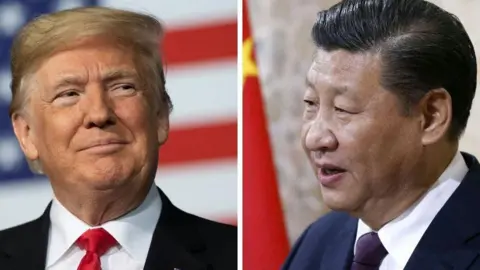In a significant development in global trade dynamics, the United States and China have taken a step back from the edge of a full-blown trade war, marking a potential ceasefire in ongoing tensions. As outlined by Faisal Islam, Economics Editor, the outcome of recent discussions held in Switzerland has unexpectedly resulted in global markets responding positively, as evidenced by rising stock prices and the resumption of operations for container ships across the Pacific Ocean.
The negotiations yielded results that surpassed initial expectations, with a commitment to lower previously high triple-digit tariffs to more manageable levels. This agreement is designed to remain in place for at least three months, providing a temporary respite for economies grappling with the effects of a trade war. Notably, it has been stated that the retaliatory tariff hikes that had characterized earlier exchanges have now been revoked. The “reciprocal” tariff rate, once set at a staggering 34%, has instead been dropped down to a mere 10% for the next ninety days.
Under the new regime, the tariff measures include a 30% rate imposed by the US, of which a substantial portion targets the trafficking of illegal fentanyl, while China has settled on a considerably lower rate of 10%. This adjustment signifies a cautious yet crucial de-escalation between the world’s two largest economies, suggesting both nations have recognized the need to step back from a precarious brink.
However, while tariffs have been modified, the details surrounding the agreement are complex, seemingly deliberately designed to allow both China and the US to maintain a semblance of dignity amid political scrutiny. The underlying economic strategies and implications remain a topic of broader concern, extending far beyond the temporary trade measures put in place. Some of these considerations include the impact of China’s exchange rate policy, which remains unresolved.
As these negotiations unfolded, there have been wider implications felt globally. The agreement has presented an opportunity for China to avert a catastrophic domestic slowdown akin to that witnessed during the 2008 financial crisis—an outcome that could have resulted in mass unemployment within its workforce. Though the adjustment in tariffs will lead to some price increases for consumers, it should facilitate continued flow in trade, thereby preserving jobs and economic engagement on both sides.
Despite the apparent progress, observers suggest that the ceasefire is not a definitive resolution to the ongoing trade tensions. For instance, the repercussions of earlier retaliatory tariffs on the US economy imply that while markets may stabilize, the potential for renewed volatility remains. Many industry insiders, including voices from small businesses and retailers, are still grappling with uncertain pricing and sourcing strategies amid fluctuating tariffs.
The recent diplomatic overtures illustrate a shift in strategy among US negotiators, notably highlighted by the appointment of Treasury Secretary Scott Bessent in leading discussions with Chinese Vice Premier He Lifeng. This shift has seen hardliners like Pete Navarro being sidelined, enabling a more pragmatic approach in negotiations. The United States acknowledges that leveraging its position depends heavily on effective diplomatic relations with allies, who now face questions about the perceived fairness of tariff impositions.
Furthermore, as this economic chess game develops, there may be an underlying competition over technological supremacy. The US may soon need to reconcile its approach in handling China’s advancements in sectors ranging from microchips to artificial intelligence while simultaneously ensuring it maintains harmonious relations with its trading partners across the globe.
In conclusion, while a significant truce has been declared, it is evident that the trade tensions between China and the US will remain a critical area for concern. The ceasing of hostilities over tariffs signals a pause rather than an end to the complex negotiations and strategic maneuvering that will continue to shape the global economic landscape for the foreseeable future. The ramifications of these developments underscore the necessity for continued vigilance and adaptability within both nations as they navigate their intertwined economic pathways.



